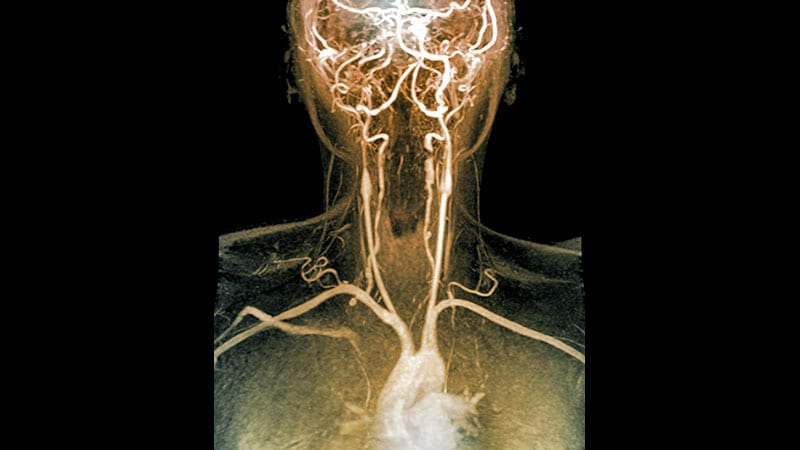핵심 개념
Patients with ischemic stroke face a significantly higher risk of myocardial infarction compared to those with cervical artery dissection alone.
초록
The research compares the risk of myocardial infarction (MI) post-stroke and cervical artery dissection (CeAD). Key points include:
- Stroke patients have nearly double the risk of MI within a year compared to those with CeAD.
- CeAD alone does not show an increased risk of MI.
- The study used data from New York and Florida inpatient databases.
- Patients with AIS alone had the highest MI risk, followed by those with concurrent CeAD and AIS.
- Patients with CeAD alone had no elevated risk of MI.
- The study adjusted for common cardiac risk factors.
- The importance of managing underlying risk factors for patients with both stroke and CeAD was emphasized.
- The study acknowledged limitations such as potential factors influencing MI risk not accounted for.
- José Biller commented on the study's execution and limitations.
요약 맞춤 설정
AI로 다시 쓰기
인용 생성
소스 번역
다른 언어로
마인드맵 생성
소스 콘텐츠 기반
소스 방문
www.medscape.com
MI Risk Higher After Stroke but Not Cervical Dissection
통계
"Compared with patients with migraine and other transient neurological events, those with an ischemic stroke have almost double the risk for myocardial infarction (MI) within a year."
"Of the total sample, 16,469 (2.32%) had MI within 1 year."
"Patients with AIS alone still had the highest risk for MI (adjusted hazard ratio [aHR], 2.20; 95% CI, 1.92-2.52; P < .001)."
인용구
"These findings suggest CeAD might be less severe in the context of cardiovascular disease."
"Most patients with CeAD are relatively young, between 30 and 50 years with a mean age of about 40 years."
핵심 통찰 요약
by Pauline Ande... 게시일 www.medscape.com 02-06-2024
https://www.medscape.com/viewarticle/mi-risk-higher-after-stroke-not-cervical-dissection-2024a10002ll
더 깊은 질문
What are the implications of these findings for the treatment and management of patients with CeAD?
The findings of the study suggest that patients with cervical artery dissection (CeAD) alone do not have a heightened risk of myocardial infarction (MI) compared to those with ischemic stroke. This has significant implications for the treatment and management of patients with CeAD. Firstly, it indicates that the focus should not solely be on the risk of MI when managing CeAD patients. Instead, healthcare providers should prioritize the treatment of underlying cerebrovascular and cardiovascular risk factors in these patients. This approach is crucial in reducing the overall cardiovascular risk profile of individuals with CeAD. Additionally, the study underscores the importance of proactive management of risk factors in patients with both stroke and CeAD, as they have a heightened risk of MI regardless of the cause of the stroke.
Is there a need for further research to explore the relationship between stroke, CeAD, and myocardial infarction?
While the preliminary findings of the study shed light on the relationship between stroke, CeAD, and myocardial infarction (MI), there is indeed a need for further research to explore this complex relationship. Future studies could delve deeper into the mechanisms underlying the increased risk of MI in patients with ischemic stroke compared to those with CeAD. Investigating whether specific subtypes of CeAD or stroke are more strongly associated with MI risk could provide valuable insights for clinical practice. Moreover, longitudinal studies that follow patients with CeAD over an extended period could help elucidate the long-term cardiovascular outcomes in this population. By conducting more comprehensive research, we can enhance our understanding of how stroke, CeAD, and MI intersect and develop more targeted approaches for patient care.
How can the study's limitations regarding factors influencing MI risk be addressed in future research?
The study acknowledged certain limitations regarding factors influencing MI risk, such as medication usage, which was not included in the databases. To address these limitations in future research, researchers can consider incorporating more detailed data on medication history, including antiplatelet agents, anticoagulants, and other cardiovascular medications. By collecting comprehensive information on medication usage, researchers can better assess the impact of pharmacotherapy on MI risk in patients with CeAD and stroke. Additionally, future studies could explore the role of lifestyle factors, such as smoking, diet, and physical activity, in influencing cardiovascular outcomes in these patient populations. By accounting for a broader range of variables that may affect MI risk, researchers can provide a more nuanced understanding of the relationship between CeAD, stroke, and cardiovascular events.
0
